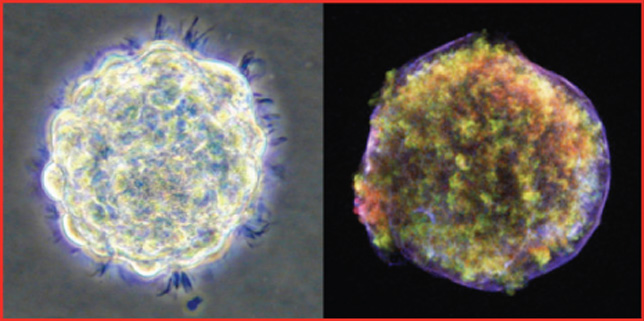
home •
about •
essential guide •
picture of the day •
thunderblogs •
news •
multimedia •
predictions •
products •
get involved •
contact
picture of the day archive subject index
Left: human stem cells. Credit: Ping Wu, M.D., Ph.D. University of Texas.
Right: Tycho supernova remnant. NASA/CXC/Rutgers/J. Warren & J. Hughes et al. Chandra observatory.
Mar 18, 2008
Bio-plasma Physics Anyone?Irving Langmuir coined the word "plasma" to refer to an ionized gas, because the way in which the electrified fluid carries ions and electrons reminded him of how blood plasma carries red and white corpuscles.
Regular readers of the Thunderbolts Picture of the Day will recall our comparison of living plasma with the electrified, space-borne kind. Perhaps the analogy is more serendipitous, or maybe even inspired, than we might imagine.
The right-hand image at the top of the page is the remnant of the giant Tycho supernova. On November 11, 1572, Tycho Brahe, the eminent Danish astronomer, first noticed the "new star" (stella nova) in the constellation Cassiopeia. The luminosity of the celestial wonder was intense enough to rival the brightness of Jupiter, eventually reaching the intensity of the planet Venus in the night sky. The shell of expanding material is about 20 light years across, five times the distance from Earth to the nearest star.
The left-hand image was obtained with an inverted light microscope displaying a group of human neural stem cells around 10 nanometers in diameter, or about .000000001 meters. Without the image credits who could tell which is which?
The supernova is approximately 10 trillion trillion times larger than the cells, or 1025 times.
In 1986, Hannes Alfvén first suggested that electrified plasma might be scalar:
"The basic properties of a plasma are likely to be the same in different regions of cosmic plasmas. The linear dimensions of plasma vary by 1027 in three jumps of 109."
Earlier in his career, in 1979, Hannes Alfvén also wrote:
"Space in general has a 'cellular structure [with] regions of different magnetization, density, temperature, electron velocity distribution and even chemical composition. Examples are: the magnetopause and magnetotail sheets, the heliospheric equatorial sheet."
While Alfvén was not referring to actual biological cells, the shape of the supernova remnant would have come as no surprise.
In a May 2000 issue of the American Journal of Physics, Mituo Uehara et al, authored a paper in which they suggested that plasma physics should be considered a part of biological investigation.
"Plasma physics can be useful in the investigation of the physical properties of living cells. Concepts like charge neutrality, Debye length, and double layer are very useful to explain the electrical properties of a cellular membrane. It is hoped that examples of physics applications to biology can be useful in giving students of physics courses new motivations to study physics and to carry out interdisciplinary studies."
So, do astrophysicists have anything in common with cell biologists? They do in the electric universe.
Contributed by Ian Tresman
www.plasma-universe.com
_______________________________________________________________________Please visit our new "Thunderblog" page
Through the initiative of managing editor Dave Smith, we’ve begun the launch of a new
page called Thunderblog. Timely presentations of fact and opinion, with emphasis on
new discoveries and the explanatory power of the Electric Universe."The Electric Sky and The Electric Universe available now!

|
|

|
EXECUTIVE EDITORS:
David Talbott, Wallace Thornhill
MANAGING EDITORS:
Steve Smith, Mel Acheson
CONTRIBUTING EDITORS: Michael Armstrong, Dwardu Cardona,
Ev Cochrane,
C.J. Ransom, Don Scott, Rens van der Sluijs, Ian Tresman
WEBMASTER: Brian Talbott
Copyright 2007: thunderbolts.info
![]()
home •
thunderblogs •
forum •
picture of the day •
resources •
team •
updates •
contact us

